Useful advice on growing a mother tongue at home.
Contents
- Teschin language - indoor flower: how correctly called scientifically, how it looks like it blooms?
- Homeland of indoor flower Teschin language
- Indoor flower of mother tongues: folk signs and superstitions, the value of a flower
- Flower of Teeth tongue: can I keep at home?
- Teschin language: useful properties
- Video: Sansevieria from cystitis
- Teschin plant language: home care, watering
- Teschin language: leaf propagation
- How to transplant a flower Teschin tongue at home?
- Video: Sansevieria: care, reproduction, transplant
Beautiful, bright green leaves of a mother-in-law's tongue can be found not only in comfort-filled and comfortable home spaces, but also in official buildings, and even in huge shopping centers. Due to its unpretentiousness in care and easy planting, the plant is familiar to many beginners and more experienced growers.
Toshchin language - indoor flower: how correctly called scientifically, how it looks, how it blooms?
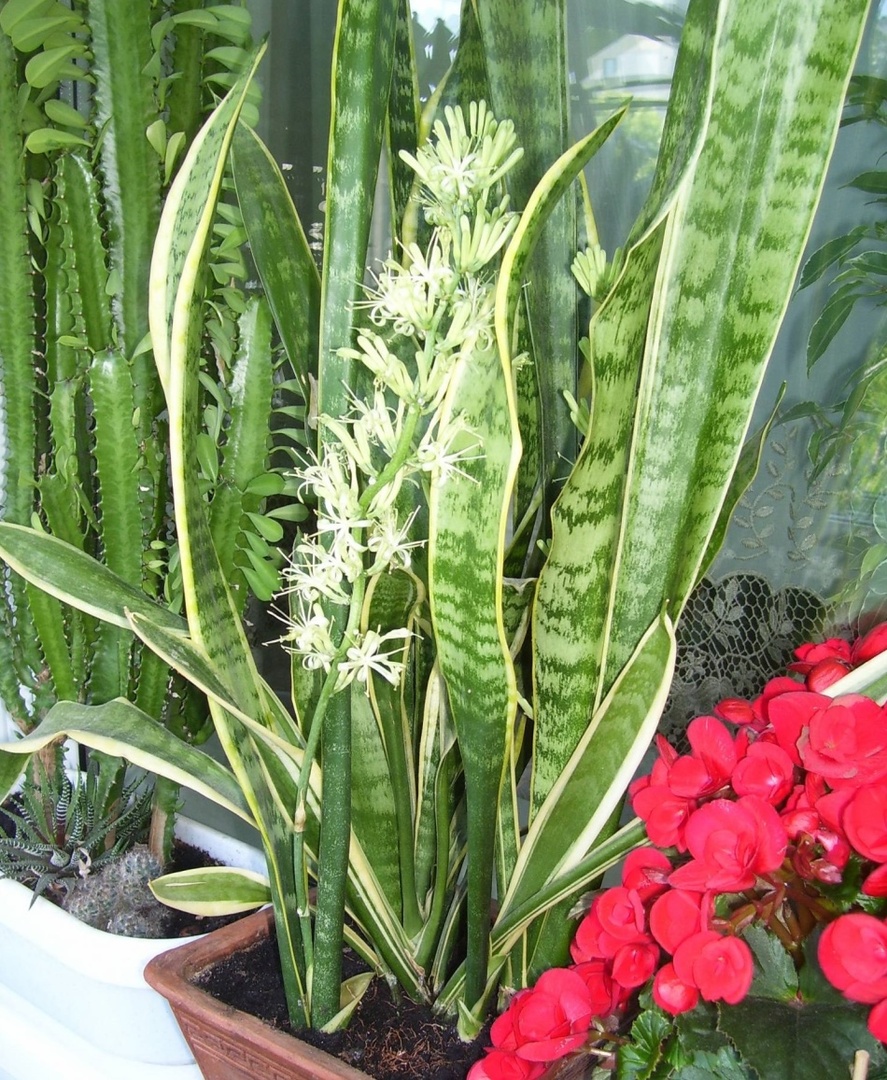 Sansevieria blooms
Sansevieria blooms The most common names are snake skin, pike tail, leopard lily, devil's tongue. The Latin name is Sansevieria( sansevera, sansevieria).
- The flower has a powerful root system, ending with radical solid leaves.
- The green crown extends over one meter in height.
- In general, leaves are elongated, acute, elongated.
- There are specimens with a crown directed to the sides or horizontally of the soil surface.
- The leaves have a variety of colors, from rich green to brownish with different impregnations: strips, spots.
- Some types of sansevier have a light wax coating, which protects them from evaporation of water.
- Flowers the plant with small - greenish-white stamens, with thin petals, collected in a dense inflorescence on an elongated straight peduncle. Gives a pleasant vanilla scent. Isolates small droplets of nectar, which in nature attracts insect pollinators.
- The most original flower is considered to be a plant species "Kirk" - beautiful fruits in the form of small berries filled with seeds.
At home, fruiting is a rarity.
Homeland of a flower in the house Teschin language
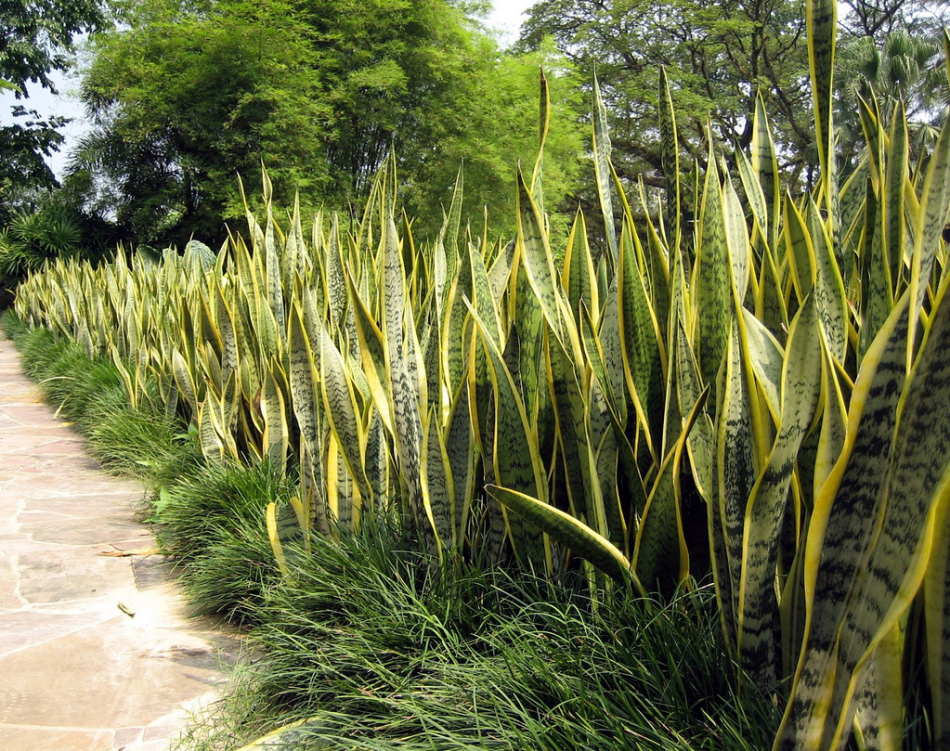 Language of the devil in natural conditions
Language of the devil in natural conditions
The heat and drought inherent in the natural climate of the growth of the mother-in-law tongue made it unpretentious and viable.
It develops equally calmly on flat terrain and among rocky surfaces.
- At home:
- As a living fence
- As a medicine in traditional medicine
- As a raw material for the production of ropes and fabrics
- In European countries, with our growers, sansevieria is often grown as a home flower for interior decoration.
Indoor flower of the mother tongue: popular signs and superstitions, the value of the flower
The plant has a huge positive energy.
Human rumor claims that:
- The African neutralizes the entire negative atmosphere in the room. Prevents or minimizes quarrels and scandals. This is helped by its long and sharp leaves, which, like antennas, catch and destroy the negative. The appearance of a flower in the apartment promotes the establishment of relations in the family.
- Gives a boost of vivacity and a sense of confidence.
- Assists in career growth.
- Is a good helper for students, improving memory when doing homework.
- Promotes lonely people to get rid of loneliness. It is recommended to have this flower in the house to meet your soul mate.
- If the leopard lily has blossomed, then this is a good sign for any endeavor.
- Winter flowering is considered a bad sign. There can be quarrels and misunderstandings with relatives.
Flower Towshin tongue: can I keep at home?
 Sansevieria for the home: the benefit of
Sansevieria for the home: the benefit of - Sansevieria is the leader in the production of oxygen. His being in the house makes home conditions more comfortable.
- In office premises loaded with office equipment, it helps employees to cope with fatigue, due to their natural filter properties.
- Absorption of negative energy, which was mentioned above, is another plus for its location in a residential building.
Teschin language: useful properties
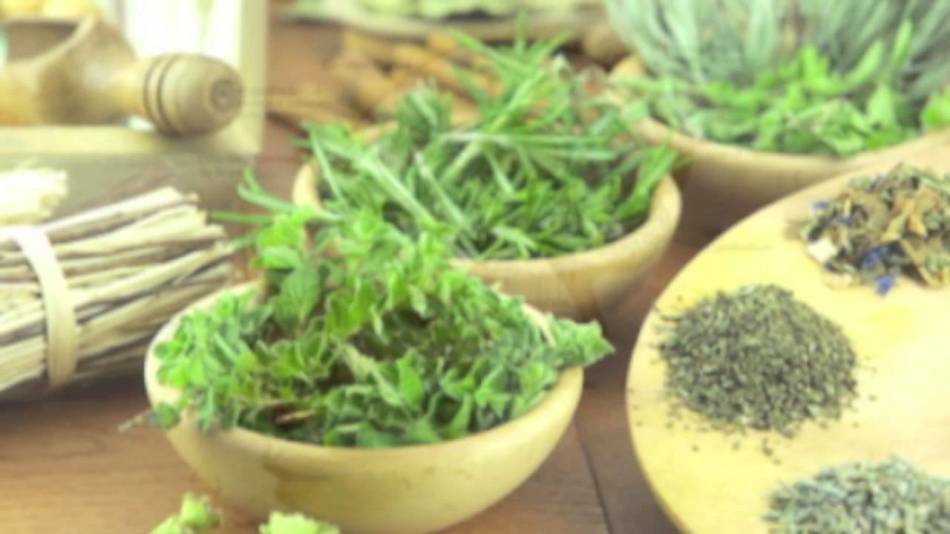 Use of the pike tail
Use of the pike tail - The value of the flower is undeniable in the fight against the inflammatory processes of the body
- It also has an analgesic effect
- Perfectly heals wounds, bruises, scratches
- Stops bleeding
- Smoke from burning tongue tongue relieves migraine
- Juices andinfusions of plants help with treatment:
- Otitis
- Angina
- Inflammation of the appendages
- Cystitis
- Gastrointestinal diseases
- Parodontosis
- Scabies
SpecieseS: Sansevieria from cystitis
Teschin plant language: home care, watering
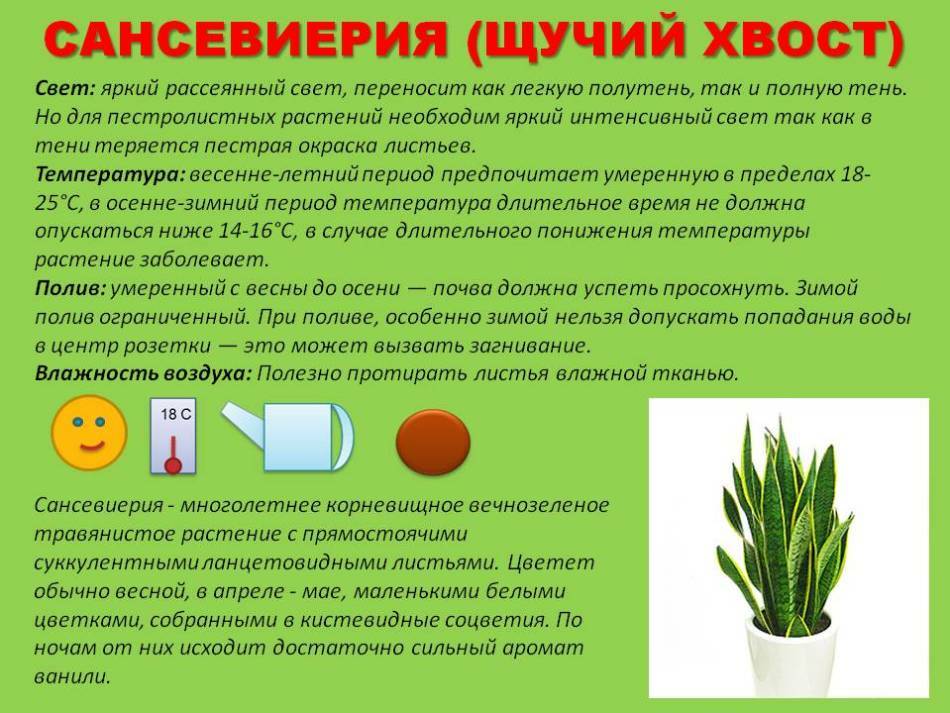 Caring for the mother tongue of the house
Caring for the mother tongue of the house Teschin tongue: leaf propagation
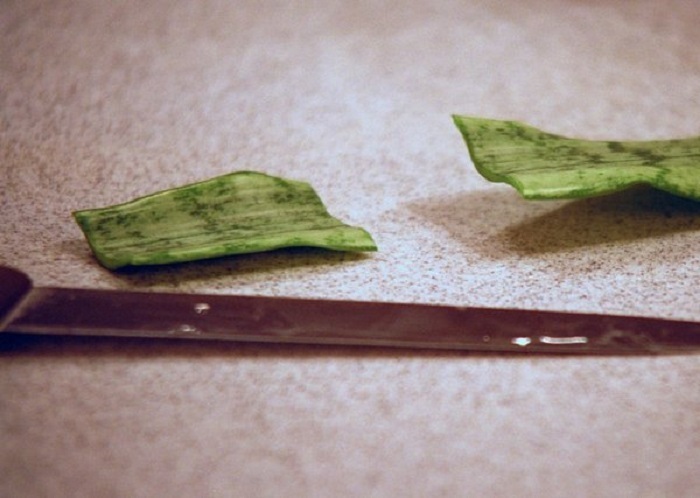 Sansevieria reproduction with the
Sansevieria reproduction with the sheet A unpretentious flower can be propagated at any time of the year, but optimal is spring.
Breeding order:
- We select a large, not damaged sheet
- We cut with a sharp knife into separate parts 6-11 cm in length.
- Prepared material is pre-conditioned for 24 hours in a ventilated, cool room.
- Then place it under a slope in sandy soil to a depth of 2-2.5see
The distance between the planting material is 3.5-4.5 cm. - Sadim into the ground with that part of the leaf that was closer to the root. Otherwise, the plant will not grow
- The pot with leaves is covered with a film, not forgetting to daily ventilate
- The temperature for germination is kept within - 20-22 degrees
- The first time watered after a day. In the future, a minimum watering is allowed, without overmoistening
- With correctly created conditions, the rooting takes place in a month
How to transplant a Teschin flower tongue at home?
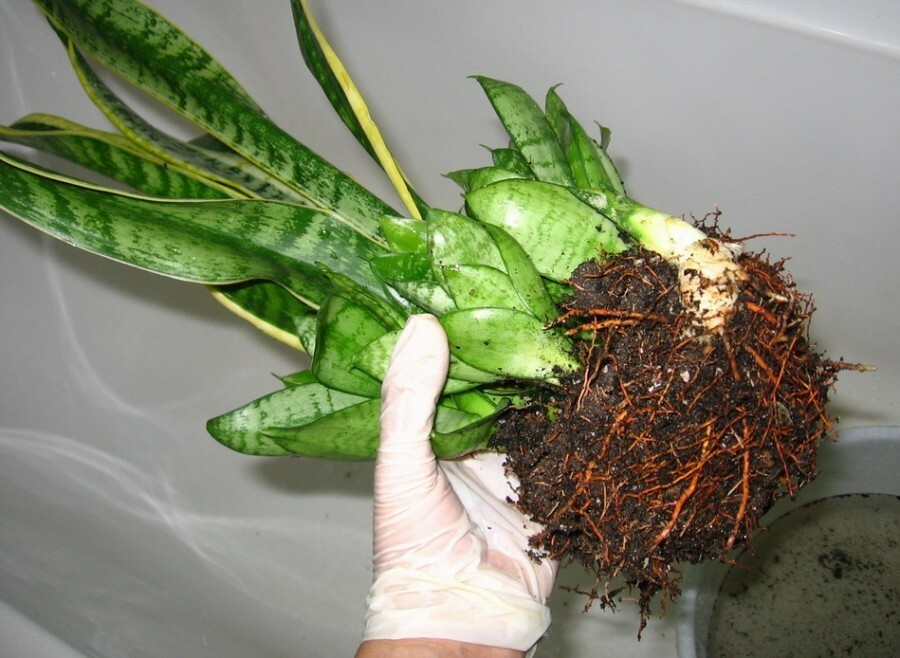 Root reproduction
Root reproduction
- Young flowers are transplanted every 3 years
- Adults are much less likely - when the roots completely clog the entire pot
The substrate is considered a suitable substrate for dracen and their family members.
You can prepare yourself by using the following components:
- Gerber - 2 parts
- Humus, leafy earth, fine sand, peat - one part
As the roots of the pike tail grow wider, the pot should be chosen low but wide.
Transition steps:
- Teschin tongue is well watered to prevent damage to the root system
- In the prepared container we fill the drainage and a bit of fresh soil
- Gently pull the plant out of the former tank
- Old soil is removed from the roots
- If necessary, cut the damaged roots. After cutting, sprinkle the damaged areas with crushed activated carbon
- In the new pot, put the flower clearly in the center
- Roots fall asleep completely
- Lightly compact the soil
- Send the mother-tongue to the penumbra for 2-3 days
- Do not water the flower for a few days
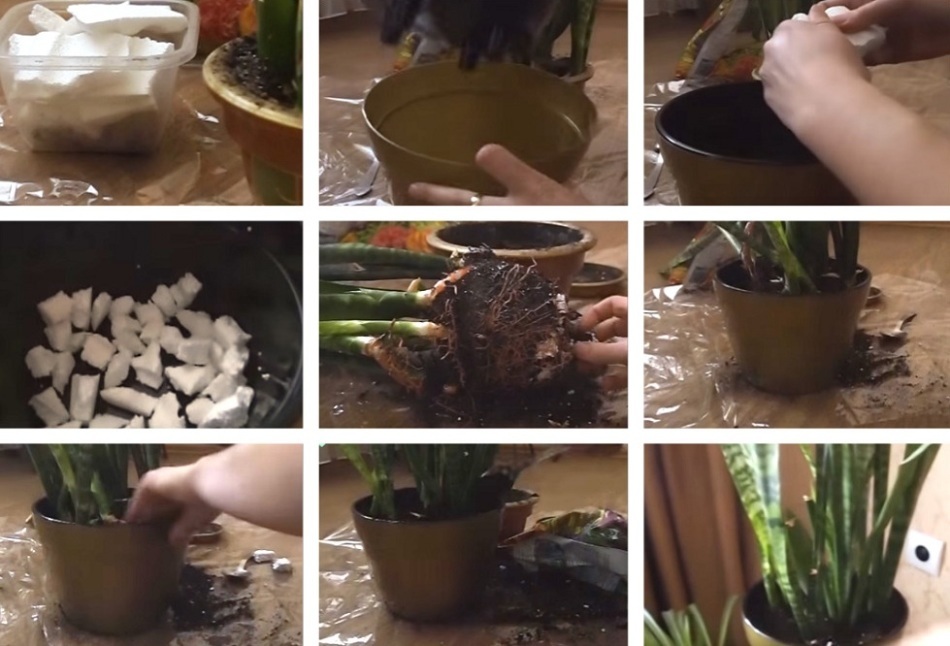 Transplant the devil's tongue at home
Transplant the devil's tongue at home
All these properties of sansevieria help to breed it even to the most negligent florist. And if the flower is properly treated and cared for, it will double your home with comfort, harmony and mutual understanding.
